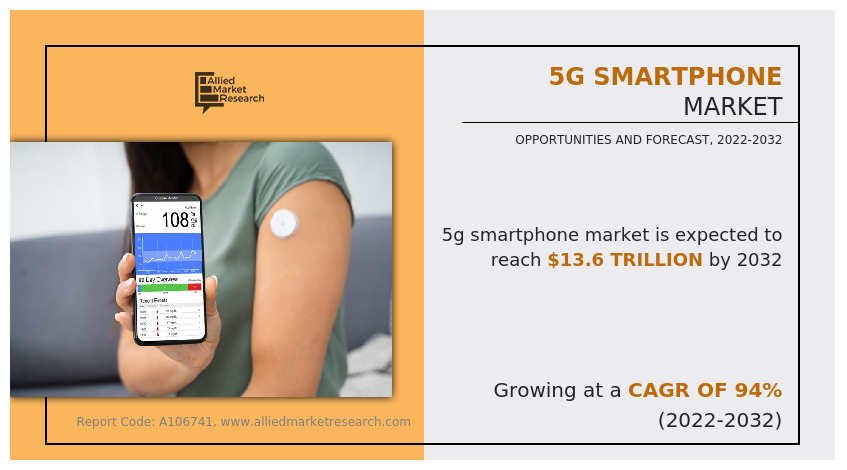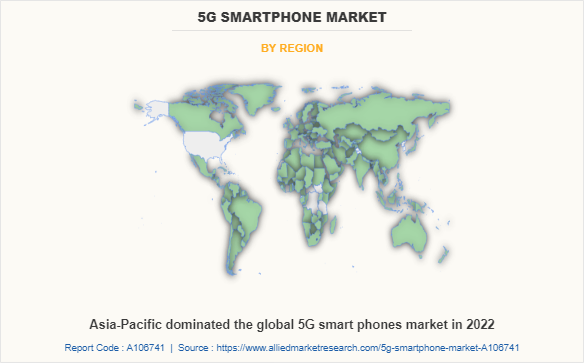5G Smartphone Market Insight, 2032
The global 5g smartphone market size was valued at USD 18 billion in 2022, and is projected to reach USD 13633.3 billion by 2032, growing at a CAGR of 94% from 2022 to 2032.
A smartphone with 5G technology enables advanced access to web-based resources and other digital features. Numerous applications developed by third parties are supported by platforms like iOS, Android, Windows Phone, and others. Governmental support for the development of telecom infrastructure, product launches that prioritize low cost, the growth of 5G technology, Artificial Intelligence (AI), and other technologies, and most importantly, rising disposable income, all contribute to the market's expansion.

The 5G smartphone market is expected to grow rapidly during the forecast period, owing to various recent trends the advent of connected IoT devices, the accelerating adoption of 5G smartphones, the increasing penetration of mobile e-commerce, and so on. With increased speed, 5G smartphones support advanced applications such as e-commerce. Thus, rising mobile e-commerce penetration is expected to aid in the market expansion of 5G smartphones. The IoT devices can provide real-time monitoring to the workplace about inventories and customers. The adoption of IoT in organizations can support businesses to manage risk efficiently. 5G technology provides the infrastructure necessary to connect a massive number of IoT devices. It offers low-latency communication, high network capacity, and efficient power consumption, making it suitable for IoT applications. As the IoT ecosystem expands, the demand for 5G-enabled smartphones to connect and control IoT devices increases.
Moreover, 5G networks have the capability to handle a massive number of connected devices within a specific area. This scalability is essential for the IoT ecosystem, which encompasses a wide range of devices such as sensors, wearables, smart appliances, and industrial equipment. 5G-enabled smartphones can efficiently manage the network capacity required to connect and interact with these devices seamlessly.
High operational and infrastructure costs are the main factors limiting the global 5G smartphone market growth. The high cost of 5G network installation and upkeep makes the cost of 5G network plans high. The deployment of 5G networks requires significant infrastructure investments from telecommunication companies. These investments include upgrading existing network infrastructure and building new towers and base stations. The costs associated with this infrastructure investment are often passed on to consumers through higher smartphone prices. Some smartphone manufacturers need to pay licensing fees to access essential patents related to 5G technology. These costs can also be reflected in the final price of 5G devices. During the forecast period, these factors are anticipated to restrain the growth of the 5G smartphone industry.
5G technology offers significantly faster data speeds and lower latency compared to previous generations. This enables users to experience seamless connectivity and real-time interactions, opening up new possibilities for applications and services. It creates opportunities for businesses to develop innovative solutions and services that rely on fast and reliable connectivity. Moreover, 5G technology delivers significantly faster data speeds compared to previous generations. This enables users to download and upload large files quickly, stream high-quality media with minimal buffering, and enjoy immersive gaming experiences. The increased speed and capacity open up opportunities for content creators, streaming platforms, and gaming companies to deliver richer and more engaging experiences to users.
In addition, 5G networks offer lower latency, which is the time it takes for data to travel between devices. This near-instantaneous communication enables real-time interactions and supports applications that require quick response times. Industries such as autonomous vehicles, remote surgeries, augmented reality (AR), and virtual reality (VR) can benefit from the reduced latency, as it allows for seamless and responsive experiences.
The key players profiled in this report include Samsung Electronics Co.Ltd., Huawai Technologies Co.Ltd., Motorola.Inc., Apple Inc., TCLCommunication Limited, LG Electronics Inc., Xiaomi Corporation, Nokia Corporation, Lenovo Group Limited, and BBK Electronics Ltd. Investment and agreement are common strategies followed by major market players. For instance, in August 2021 Samsung introduced the ‘Galaxy Z Flip3 5G’ and ‘Galaxy Z Fold3 5G’, the innovative foldable mobile phone. With iconic design, both the devices are built with flagship innovation, offering a unique user experience to work.
Top Impacting Factors -
Growing Adoption of 5G Technology:
The increasing rollout of 5G networks worldwide is driving demand for 5G-enabled smartphones. As carriers expand 5G coverage, consumers are upgrading their devices to take advantage of faster speeds, lower latency, and improved network performance.
Technological Advancements in Smartphones:
Smartphone manufacturers are continuously innovating to improve performance, battery life, and connectivity. The integration of advanced processors, AI capabilities, and enhanced camera systems makes 5G smartphones more appealing to consumers, boosting 5g smartphone market growth.
Increasing Demand for High-Speed Connectivity:
With more reliance on mobile devices for streaming, gaming, and data-intensive applications, consumers and businesses seek faster and more reliable internet access. 5G technology meets this demand by offering significantly higher download and upload speeds, supporting emerging applications like augmented reality (AR) and virtual reality (VR).
Price Competition:
As more smartphone manufacturers enter the 5G market, competition has driven down the cost of 5G smartphones. This has made the technology more accessible to a broader range of consumers, especially in developing regions, further expanding 5g smartphone market penetration.
Economic Recovery and Consumer Spending:
Post-pandemic economic recovery has boosted consumer spending on tech gadgets, including smartphones. Coupled with promotional offers and trade-in programs, this has led to an increase in 5G smartphone sales globally.
Segment Review
The global 5G smartphone industry is segmented on the basis of operating system, sales channel, and region. By operating system, the market is sub-segmented into Android, Windows, IOS, and Others. By sales channel, the market is classified into online and offline channels. By region, the market is analyzed across North America, Europe, Asia-Pacific, and LAMEA. The market is segmented into Operating System and Sales Channel.

By operating system, the android sub-segment dominated the market in 2022. Android is an open-source operating system, allowing multiple smartphone manufacturers to adopt and customize it for their devices. This has led to a wide range of Android-based smartphones available in the market, including 5G-enabled devices. The availability of diverse options gives consumers more choices and promotes the adoption of Android-based 5G smartphones. The most popular mobile operating system worldwide as of 2022 is Android. Moreover, the android ecosystem includes a vast array of applications, services, and developer support. With millions of apps available on the Google Play Store, Android users have access to a wide range of software and services that enhance their smartphone experience. This robust ecosystem attracts users and contributes to the demand for Android-based 5G smartphones.
Furthermore, Android has been actively working to integrate and optimize its operating system for 5G networks. The Android platform provides support for the necessary technologies and protocols required for 5G connectivity, enabling seamless integration with 5G networks. This compatibility helps manufacturers deliver 5G-enabled smartphones that leverage the full potential of the network. These are predicted to be the major factors affecting the 5G Smartphones market size during the forecast period too.

By sales channel, the online channel sub-segment dominated the global 5G smartphones market share in 2022. The rapid growth of e-commerce platforms has transformed the way people shop for products, including smartphones. Online marketplaces and e-commerce websites provide a wide range of options, competitive pricing, and convenience in terms of doorstep delivery. These factors have contributed to the popularity of online channels for purchasing 5G smartphones. With the growth of 5G technology, there is an increasing demand for high-speed internet connectivity. This has led to a significant rise in internet penetration globally.
As more people gain access to the internet, online channels become a convenient and accessible platform for purchasing 5G smartphones. Online channels offer a vast array of 5G smartphones from various brands and manufacturers. Customers can easily compare different models, features, and prices, enabling them to make informed decisions. The availability of a broader product selection is a significant driver for consumers who prefer online channels for purchasing 5G smartphones.

By region, Asia-Pacific dominated the global market in 2022 and is projected to be the fastest-growing sub-segment during the forecast period. The growing usage of mobile devices has boosted the Asia-Pacific market for 5G smartphones. One of the most profitable markets is India. Good digital infrastructure, growing e-commerce acceptance, rising internet usage, and the availability of 5G-compatible phones are major reasons for the regional market growth. Due to the production-linked incentive (PLI) program, which encouraged manufacturers all over India to establish mobile global production hubs, exports from India have increased. For instance, the India Brand Equity Foundation reported that 10.9 million smartphones were exported from India between January and September 2020. In turn, this is promoting 5G smartphone industry expansion all across the nation.
Impact of COVID-19
- Numerous industries have seen a significant change in their business as a result of the COVID-19 pandemic. The temporary suspension of manufacturing activities across a number of nations in order to contain the coronavirus has also had a significant impact on the expansion of the 5G smartphones market.
- Due to production disruption, there is also a shortage of 5G chipsets on the market. Numerous manufacturing firms, including Samsung, Xiaomi, OPPO, and LG Display, have stopped producing goods in China, India, South Korea, and Europe.
- For instance, the OPPO Company ceased operations in Noida, India, in May 2020. The lockdown imposed in several nations has also decreased the demand for 5G smartphone devices.
Key Benefits for Stakeholders
- This report provides a quantitative analysis of the global 5G smartphone market share segments, current trends, estimations, and dynamics of the 5g smartphone market analysis from 2022 to 2032 to identify the prevailing market opportunities.
- The market research is offered along with information related to key drivers, restraints, and opportunities.
- Porter's five forces analysis highlights the potency of buyers and suppliers to enable stakeholders make profit-oriented business decisions and strengthen their supplier-buyer network.
- In-depth analysis of the market segmentation assists to determine the prevailing market opportunities.
- Major countries in each region are mapped according to their revenue contribution to the global market.
- Market player positioning facilitates benchmarking and provides a clear understanding of the present position of the market players.
- The report includes the analysis of the regional as well as global 5g smartphone market trends, key players, market segments, application areas, and market growth strategies.
- The report provides the indepth analysis about the 5G smartphone market forecast.
5G Smartphone Market Report Highlights
| Aspects | Details |
| Market Size By 2032 | USD 13633.3 billion |
| Growth Rate | CAGR of 94% |
| Forecast period | 2022 - 2032 |
| Report Pages | 320 |
| By Operating System |
|
| By Sales Channel |
|
| By Region |
|
| Key Market Players | Huawei Technologies Co., Ltd., bbk electronics ltd., LG Electronics Inc., Samsung Electronics Co. Ltd., Lenovo Group Limited, Nokia Corporation, TCL Communication Limited, Xiaomi Corporation, Apple Inc., Motorola, Inc. |
The global 5g smartphone market size was valued at $18 billion in 2022, and is projected to reach $13633.3 billion by 2032.
The 5g smartphone market is projected to grow at a compound annual growth rate of 94% from 2022 to 2032.
Samsung Electronics Co.Ltd., Huawai Technologies Co.Ltd., Motorola.Inc., Apple Inc., TCLCommunication Limited, LG Electronics Inc., Xiaomi Corporation, Nokia Corporation, Lenovo Group Limited, and BBK Electronics Ltd. are the major players in the 5G Smartphones market.
Asia-Pacific will provide more business opportunities for the global 5G Smartphones market in future.
Video content is becoming increasingly popular, and 5G technology provides the necessary bandwidth and low latency to support high-quality video streaming on mobile devices. This is particularly important for consumers who use their smartphones to watch movies, TV shows, and other video content on-the-go.
Loading Table Of Content...
Loading Research Methodology...



